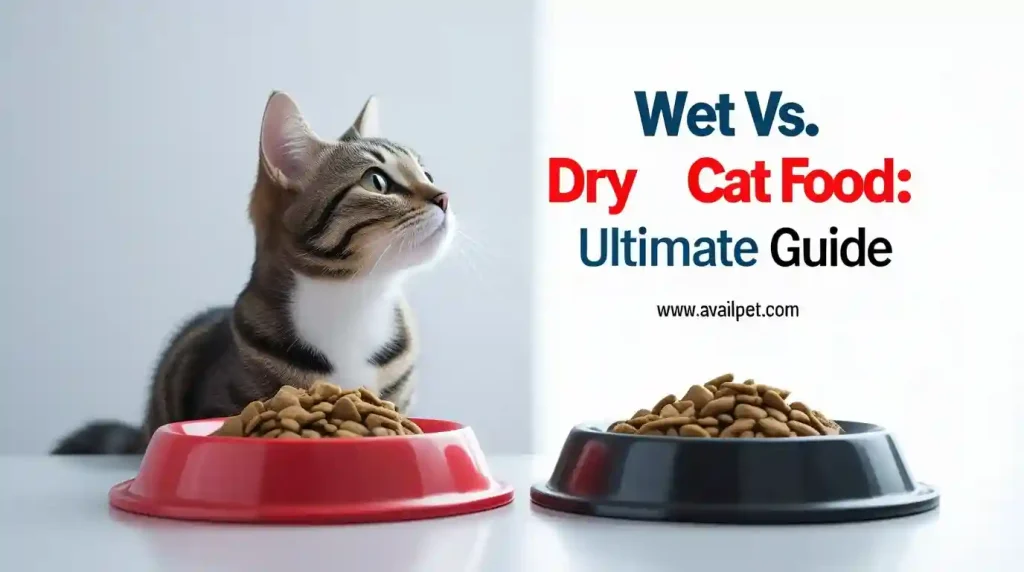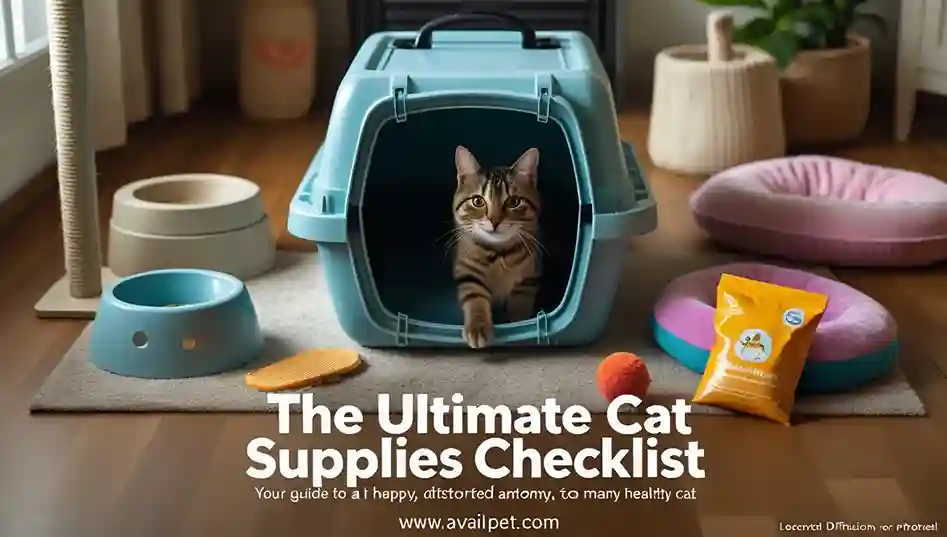That “fresh spring breeze” or “clean linen” scent wafting from your cat’s litter box might be pleasing to you, but to your cat, it could be an overwhelming chemical assault. The choice between scented and unscented cat litter is one of the most common dilemmas for pet owners, but it’s often approached from the wrong perspective: human preference over feline well-being.
The truth is, this decision carries significant weight. The wrong choice can lead to a cat who develops respiratory issues, experiences stress, and—most frustratingly—starts avoiding the litter box entirely, a common problem we address in our guide to Cat Not Using Litter Box.
At AvailPet, we believe in choices backed by science and veterinary expertise. This definitive guide cuts through the marketing claims to give you a clear, evidence-based comparison of scented vs unscented cat litter, empowering you to make the safest, healthiest choice for your feline companion.
Key Takeaways: Scented vs Unscented Cat Litter
Before we dive into the detailed comparison, here are the most critical, evidence-based insights from veterinary science and feline behavior research:
- 👃 Olfactory Reality: A cat’s sense of smell is 14 times stronger than a human’s, making artificial fragrances overwhelming and potentially stressful.
- 🩺 Veterinary Consensus: Unscented litter is overwhelmingly recommended by veterinarians and behaviorists to prevent health and behavioral issues.
- ⚠️ Documented Health Risks: Artificial fragrances can contain chemicals that trigger asthma, respiratory inflammation, and allergic reactions in sensitive cats.
- 🚫 Primary Behavioral Impact: Scented litter is a leading cause of litter box avoidance, as the strong smell can deter a cat from entering the box.
- 🌿 Effective Natural Solutions: True odor control is achieved through ingredients like baking soda, activated carbon, and plant enzymes—not masking perfumes.
At-a-Glance Comparison: Scented vs Unscented Cat Litter
This quick-reference table outlines the core differences to help you understand the fundamental trade-offs.
| Aspect | Scented Litter | Unscented Litter |
|---|---|---|
| Cat Acceptance Rate | Lower – often rejected | Higher – widely accepted |
| Health Safety Profile | Higher Risk of irritation | Generally Safer |
| Primary Odor Control Method | Masking with perfumes | Neutralizing with ingredients like baking soda |
| Ideal Use Case | Primarily for human preference in well-ventilated areas | All situations, especially for cats with health issues or in multi-cat homes |
| Veterinary Recommendation | Rarely advised | Consistently recommended |
The Science of Smell: Understanding Feline Olfactory Sensitivity
To understand why the scent debate matters, you must first appreciate the vast difference between your cat’s sensory world and your own.
- Biological Capacity: Where humans have approximately 5-6 million olfactory receptors, cats possess a staggering 200 million. This allows them to detect scents at concentrations nearly undetectable to us.
- Instinctual Behavior: A cat’s sense of smell is integral to their communication and territory marking. A heavily perfumed litter box doesn’t just smell “nice”—it can obscure their own scent markers, causing confusion and stress by masking the familiar smells that make them feel secure.
- Health Implications: This heightened sensitivity means that volatile organic compounds (VOCs) released from synthetic fragrances are not just unpleasant for your cat; they can be physically irritating, potentially exacerbating or even contributing to conditions like feline asthma and chronic respiratory inflammation.
The Hidden Dangers of Scented Cat Litter
While the promise of a fresh-smelling home is appealing, the ingredients used to create those scents can pose real risks to your cat’s health and well-being.
- Common Chemical Additives: Many scented litters use phthalates, synthetic musks, and volatile organic compounds (VOCs) to create and sustain their fragrances. These chemicals are released into the air every time your cat digs or the litter is disturbed.
- Documented Health Risks:
- Respiratory Distress: Inhaled particles and VOCs can irritate the delicate lining of the nasal passages and lungs, potentially triggering or worsening asthma and other respiratory conditions.
- Dermal Absorption: Cats’ paw pads are permeable. Chemicals from the litter can be absorbed directly into their system as they stand in the box.
- Ingestion Risks: Cats are fastidious groomers. Any litter dust or particles that stick to their fur will be ingested when they clean themselves, introducing these chemicals internally.
- Allergic Reactions: Sensitive cats can develop skin irritations, excessive itching, or other allergic symptoms from exposure.
- Behavioral Consequences: The overpowering smell can be so aversive that a cat will simply refuse to enter the box, leading to inappropriate elimination elsewhere. This is a direct survival instinct to avoid areas with overwhelming, potentially “dangerous” smells.
- When Scented Might Be Tolerated: The only scenario where a scented litter may be considered is in an extremely well-ventilated, single-cat home where the cat has used it without issue for years and has a clean bill of health from a veterinarian. Even then, the risks remain.
Why Unscented Litter Wins: Health & Behavioral Benefits
Choosing unscented litter isn’t just avoiding potential harm—it’s actively choosing a product that supports your cat’s health and natural behaviors.
- Natural Odor-Control Technologies: Unlike scented litters that mask smells, unscented litters work to eliminate them using safe, effective methods:
- Baking Soda: A natural mineral that neutralizes acidic urine odors through pH balance.
- Activated Carbon: A highly porous substance that traps and holds odor molecules.
- Plant-Based Enzymes: Break down the waste itself, targeting the source of the smell.
- Proven Health Advantages: By eliminating synthetic fragrances and their associated VOCs, unscented litter significantly reduces the risk of respiratory irritation and allergic reactions. This makes it the safer choice for all cats, but it is especially critical in multi-cat households where the cumulative exposure is higher and for breeds prone to asthma, like Siamese.
- Behavioral Benefits: A neutral-smelling environment allows a cat’s own scent markers to remain, making the box a familiar and secure territory. This leads to higher litter box acceptance and more consistent use, preventing the stress and mess of avoidance. For a deep dive on this issue, see our guide Cat Not Using Litter Box.
- Top Unscented Choices: High-performance unscented litters are available in every category:
- Clumping Clay: Dr. Elsey’s Ultra Premium
- Grass Seed: SmartCat Clumping Grass Litter
- Paper: Fresh News Paper Litter
- Wood: Ökocat Natural Wood Clumping Litter
Scenario-Based Selection Guide
Use this practical guide to make the right choice for your specific situation.
Choose UNSCENTED Litter When:
- Introducing any new litter to a cat
- Your cat has a history of litter box avoidance
- You have multiple cats sharing boxes
- Respiratory issues are present (in your cat or human family members)
- You are prioritizing long-term feline health
- Your cat is a kitten or a senior with heightened sensitivities
Consider SCENTED Litter Only When:
- Your cat has reliably accepted a specific scented litter long-term
- You need temporary odor control between full litter changes
- Excellent ventilation is guaranteed in the litter box area
- There are human sensitivity issues with natural litter odors
- You’re willing to monitor closely for any signs of rejection or health issues
Remember: Even in these scenarios, unscented litter with good maintenance is typically a better solution. For help maintaining a fresh box, see our guide on How Often to Change Cat Litter.
Safe Transition Strategies Between Litter Types
If you need to switch your cat from scented to unscented litter (or between any types), a gradual approach is crucial to ensure acceptance and prevent accidents.
- The Gradual Mixing Method (Recommended):
- Days 1-3: Mix 25% new unscented litter with 75% old scented litter.
- Days 4-6: Use a 50/50 blend of both litters.
- Days 7-10: Mix 75% new unscented litter with 25% old scented litter.
- Day 11+: Transition to 100% unscented litter.
- The Emergency Protocol (For Immediate Needs):
- If a sudden health issue requires an immediate switch, completely empty and wash the litter box with an enzymatic cleaner to remove all scent residue.
- Fill the pristine box with the new, unscented litter.
- This method carries a higher risk of rejection but may be necessary.
- Troubleshooting Rejection:
- If your cat refuses the new mix, slow down the transition. Revert to a previous ratio for a few more days.
- As a bridging solution, use a cat-attractant litter like Dr. Elsey’s Cat Attract, which uses natural herb scents to encourage use, before transitioning to a plain unscented litter.
FAQs: Your Scented vs Unscented Cat Litter Questions Answered
Is scented litter actually harmful to cats?
It can be. While not toxic in the traditional sense, the chemicals in synthetic fragrances can cause respiratory irritation, allergic reactions, and stress. For cats with pre-existing conditions like asthma, it can be particularly problematic. The consistent veterinary recommendation is to avoid it.
Can litter fragrances cause respiratory problems?
Yes. The dust from scented clay litters, combined with volatile organic compounds (VOCs) from the fragrance, can be inhaled and irritate the delicate lining of a cat’s airways. This is a known trigger for feline asthma and chronic bronchitis.
Why does my cat consistently avoid scented litter?
Your cat’s powerful sense of smell is likely being overwhelmed. The artificial perfume masks their own scent markers, making the box feel unfamiliar and unsafe. It’s a natural instinct to avoid eliminating in an area that smells strongly of potential “danger” or doesn’t smell like their own territory.
What’s the most effective unscented litter for odor control?
The most effective unscented litters use other powerful technologies. Look for litters with activated carbon or baking soda for ammonia neutralization, or plant-based materials like grass or wood that naturally inhibit bacterial growth and odor. Our reviews of the Best Clumping Cat Litter highlight top-performing unscented options.
Are there any safe scented litter alternatives?
The safest “scented” alternatives are those that use natural, mild essential oils (in very low concentrations) or herbal blends specifically designed for cats, like those in some cat-attract litters. However, these can still be off-putting to some cats, and pure unscented remains the safest bet.
Professional-Grade Odor Control Strategies
Eliminating litter box odor doesn’t require perfumes—it requires a smart system. Implement these professional strategies for a truly fresh home.
- The Non-Negotiable Maintenance Protocol:
- Scoop waste from the box at least twice daily to remove the primary source of odor.
- Perform a full litter change and deep clean of the box on a regular schedule, typically every 2-4 weeks for clumping litter.
- For a detailed cleaning schedule, see our guide: How Often to Change Cat Litter
- Environmental Control Solutions:
- Use a HEPA air purifier near the litter box area to capture airborne dust and dander.
- Place an open box of baking soda in the room to passively neutralize ambient odors.
- Ensure the room has adequate ventilation, whether through a window or an exhaust fan.
- Litter Box Enhancements:
- Choose boxes with built-in carbon filters if using a covered design.
- Select litter made from natural, absorbent materials like grass, wood, or corn, which often have innate odor-fighting properties.
- Effective Cleaning Systems:
- Use an enzymatic cleaner for any accidents outside the box to eliminate the scent completely and prevent repeat offenses.
- Wash the litter box itself with mild, unscented soap during deep cleans to avoid transferring chemical smells.
Conclusion: Prioritizing Feline Health Over Human Preference
The choice between scented and unscented cat litter ultimately comes down to a single question: are you choosing for your nose or your cat’s well-being? While a perfumed box might offer short-term olfactory relief for you, it can create long-term health and behavioral problems for your feline companion.
By choosing an unscented litter and relying on natural odor-control methods and consistent maintenance, you are making an evidence-based decision that respects your cat’s biological needs. This approach prevents respiratory risks, avoids litter box aversion, and creates a bathroom environment your cat will actually want to use. For a complete overview of creating the ideal litter box experience, from setup to product selection, our comprehensive Cat Litter Guide is your ultimate resource.
Sources
- Cornell Feline Health Center – Litter Box Problems
- International Cat Care – Litter & Litter Boxes
- ASPCA – Litter Box Care
Disclaimer: Our litter recommendations are based on veterinary guidance and scientific research into feline health and behavior. Individual cat sensitivities may vary. We are not veterinarians. For specific health concerns regarding your cat, please consult your veterinarian. We may earn from qualifying purchases through our affiliate links.






